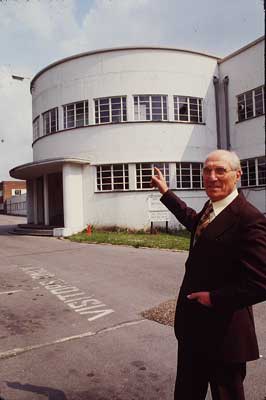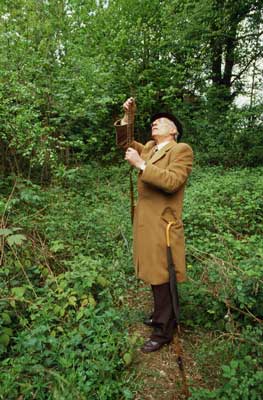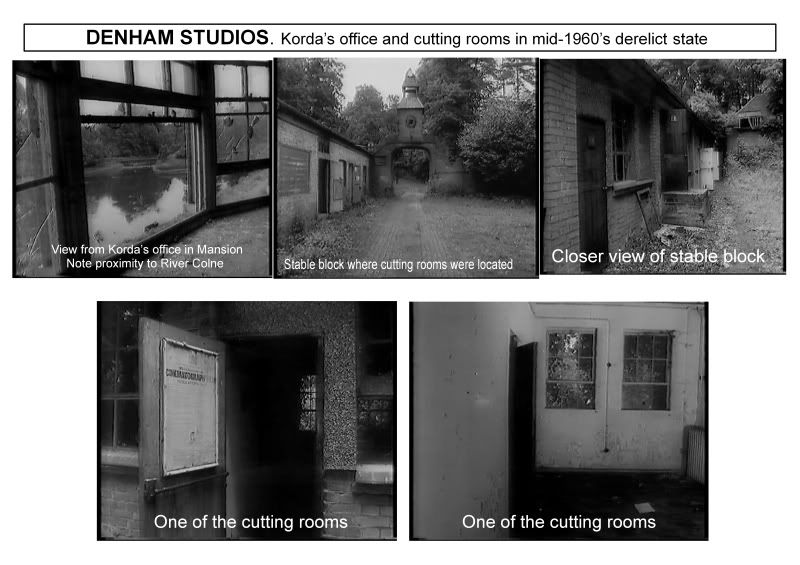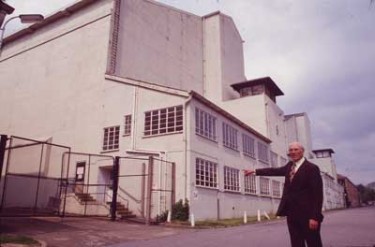These pictures from Mr Smith’s collection show a visit in 1977 to Denham Film Studios just before the demolition began.
The photographs show Herbert Smith who had run Denham from 1945 to 1950 and been a very influential person in the Film World throughout his life.
Herbert Smith had been previously working at Beaconsfield Studios for some time when in 1945 he accepted an offer from Two Cities Films to join them at Denham. He was Executive in charge of productions with a splendid office on the first floor overlooking the entrance – pictured below.
A very famous name in Denham Film Studio’s history is that of Herbert Smith – ABOVE.
Herbert Smith, who was the brother of the late Sam Smith, founder of British Lion Films, was a well known figure in the British film industry with which he has been connected for many years. He continued to control productions at Denham till it closed in 1950.
He was Executive Producer of Walt Disney’s Treasure Island 1950 at Denham – although he is uncredited simply becuse this is the way he seemed to want it. He had his name removed from the credits of quite a few of the classics made at Denham
Pictures show Herbert Smith at his Old Office, Large Sound Stage, Grand Hall – now in ruins, and the Cutting Room.




Below: A Fire Engine arrives at Denham Film Studios 1941

Interesting picture – above top left – of what was Alexander Korda’s office in the old mansion and see how close it is to the River Colne. I remember Michael Powell telling the story that he had attended a film story meeting for the film The Spy in Black in this very office at Denham – and present was Alexander Korda, the author of the book and another man who he had not met before but who had actually adapted the novel for the screen. Michael Powell said that this man was asked to read out the bear bones of his story – which he proceeded to do.
Michael said that he thought immediately that this man was a genius in the way he had adapted the story – he had, from the original, turned the story completely on its head – but it was good.
That person turned out to be Emric Pressburger and thus began one of the most famous partnerships in film history – Powell and Pressburger.

The two great men – above.
Michael Powell and Emeric Pressburger were the most original filmmaking team in the history of British Cinema. The films that they made together under the name of their production company ‘The Archers’ include some of the most critically celebrated and best loved films ever made in Britain.
Their work from the 40s, included – ‘The Life and Death of Colonel Blimp’, ‘A Canterbury Tale’, ‘I Know Where I’m Going’, ‘A Matter of Life and Death’, ‘Black Narcissus’, AND ‘The Red Shoes’.
These would be good films by any standard and in any era. They were just so original in style.
Kathleen Byron who starred as Sister Ruth in Black Narcissus above – from the novel by Rumer Godden – said that when Michael Powell offered her the role he said that it was a great part – but he added ‘make the most of it Kathleen because you will never get a part as good again’. And she said that he was quite right – she never did get as good a part as that again even though her career lasted for many years afterwards. Interesting little story I think.



I’m visiting Denham soon and I’d be interested to know if you think the former Rank/Deluxe lab building that’s now luxury housing is now the only remaining evidence of the former Denham studio, or could there (e.g.) be ruins of anything close to the River Colne, if the studio extended to this?
Adrian. Thanks for your comment here. I know that the Denham Film processing division which went on long after the Studios were demolished stood and is maybe part of the new Development. I once stopped there but was only allowed access into the Car Park which they referred to as the ‘tank’ car park as it was the site of the old studio tank for water scenes. I think Alexander Korda’s Office was part of the old house there which was down towards the River Colne. It was a very big site in it’s hey day. Whenever I pass there I get a feeling about the place and somehow imagine myself back in those great days. I don’t go by very often though. Quite nearby is Burnham Beeches used in many films done at Denham – most notably in The Story of Robin Hood and His Merrie Men filmed there in the summer of 1951 – sadly the last film ever made at Denham. It seems ironic that Walt Disney chose Denham for Treasure Island and then soon after The Story of Robin Hood, and both were successful so you might have thought it could have breathed new life into the Studio – it did but sadly not for long.
Great website!
I am currently watching Things to Come, filmed at Denham Film studios and released in 1936. Producer was Alexander Korda the founder of the studios.
Hats off to Kubrick, but the special effects and visual effects they made in the 1930s was even more remarkable.
Of course we enjoy every New Bond movie (made at the neighbor’s studio) but what they deliver nowadays for roughly a quarter of a billion dollars … They should be ashamed when you see what they were capable of in the past. Makes me sad. Greetings from the Netherlands, Charles.
Charles. Many Thanks for your comment here and I must apologise for taking more that 2 weeks to reply. Yes, what filmmakers of those days were able to produce on screen is astonishing. I think back to Peter Ellenshaw whose work for Walt Disney at Denham on Treasure Island and The Story of Robin Hood and His Merrie Men, is breathtaking with those Matte Paintings that were ‘realer than real’ – and before this Percy Day and Peter his step son combined to such great effect on ‘Black Narcissus’ I have a feeling that Percy Day was involved a lot on ‘Things to Come’ too. Another one a bit later for Walt Disney was ‘Darby O’Gill and the Little People’ where the special effects were dazzling and nearly unbelievable. Thanks for your comments on the Web Site and I am pleased you enjoy it. Please keep reading. Neil
… [Trackback]
[…] There you will find 56680 additional Information on that Topic: filmsofthefifties.com/denham-film-studios-revisited/ […]
… [Trackback]
[…] Find More on that Topic: filmsofthefifties.com/denham-film-studios-revisited/ […]